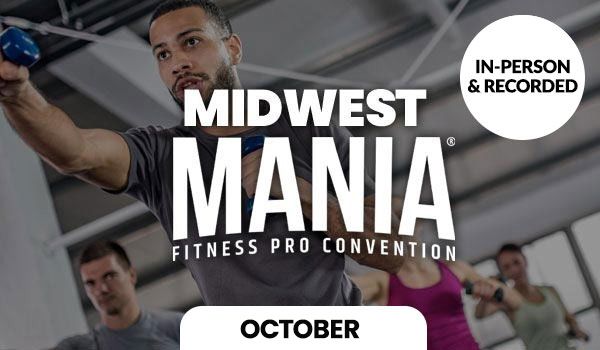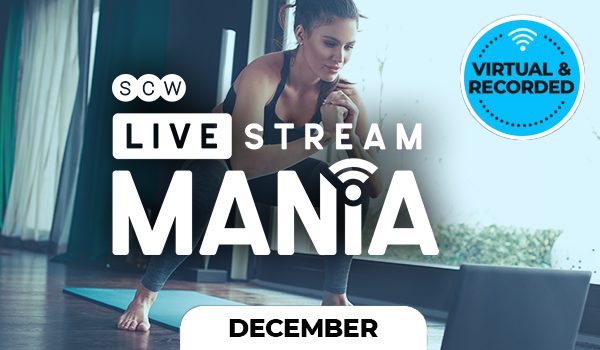
SCW Spotlite: Issue 52

Group Exercise Instructor Recruitment Strategies
by Sara Kooperman, JD
Most fitness managers know the keys to finding a great group exercise instructor is looking for personality and passion. This combination is a guaranteed winner. But the big question is: How do we find these people? Where are they hiding? And most important of all is how do we recruit and retain them?
During the pandemic, many group exercise instructors figured out ways to make ends meet. Since there were no group exercise classes because the clubs were closed, most quickly transitioned to Facebook live, Instagram live, as well as Zoom. The technologically savvy group ex instructor was able to pull their classes together and generously support their clubs that were “temporarily” closed, by teaching online.
We all thought that the pandemic was only going to last until Easter, and after being closed for three weeks, we would easily and smoothly reopen. Sadly, the pandemic dragged on for two more years. This meant that instructors were either out of work for two years or needed to find another avenue as their creative outlet.
Many instructors found other part-time jobs they could teach online and others figured out ways to charge for their virtual classes. But in general, it seems most instructors shifted and chose to no longer connect with their clubs.
This struggle wasn’t one-sided. Clubs were stressed to pay rent, transition virtually, and simply make ends meet. Finding, applying, and securing governmental loans along with outside and inside financial support became a priority. Struggling to survive, many clubs forgot about their group exercise staff. This seemed to be the case, more often than not, even before the pandemic. Group exercise is not an area that general managers, CEOs, accountants, or marketing teams pay attention to. Revenue and retention along with acquisition and accumulation tend to be the focus of any fitness facility. 
In order to survive, this left group exercise instructors on their own to figure out what to do and where to go. Then, when the pandemic restrictions lifted and clubs wanted to re-open to again offer group exercise, where had all the instructors gone?
Group Ex leaders went out on their own, in droves. As mentioned, virtual training and teaching became all the rage and helped supply the supplemental income that group fitness promised.
How do we get the instructors back?
The first place to look for group fitness instructors is referring to your pre-pandemic roster and reconnecting with your premiere professionals. These are the ones who pulled in the most attendance and the membership loved. What clubs need to understand is that group fitness instructors do not review their position as a “job,” they view it as a profession. This is their passion and mission. Connecting with these special people requires respect and finesse. Reach out to your best instructors. It’s ok to bribe and beg them to come “home.” Remind them how much the students need and worship them. This is not merely playing to an instructor’s ego, this is securing your clubs future and your member satisfaction. Contact your best and hardest working teachers and offer to pay them more. Do what it takes to get them back. Let them know it’s OK, and even encourage them, to keep their personal online training businesses, but ask them respectfully and honestly to return.
Often, though, the bridges may have already been broken. We may need to find new instructors. So where do we look? Where is our talent? Here we are back to personality and passion.
The first person to find is your group exercise coordinator. You cannot just throw a general manager, front desk coordinator, or even a personal training director into this role. Find someone who has possibly done this in the past and who can command respect from other group exercise instructors while still having management skills. When looking for the best group ex coordinator does not mean searching for the best teacher. It means finding the best manager. Look for an individual who can stroke egos and gently ensure timeliness, commitment, and quality.
While some clubs are still struggling to return, at times there seems to be a heightened sense of competition, even with an underlying sense of “we are all in this together.” If clubs can share group fitness instructors, they can also share a coordinator. This may serve two purposes. Not only would provide some extra income to the group fitness director; this could save both clubs money, especially if the facilities were close enough in proximity.
Often clubs wonder if they should have unique instructors to personally cultivate and keep to themselves. I think this concept is important. If you can pull a stellar, top instructor into exclusivity, by paying a bit more and providing them preferred classes, then it’s a win for everyone. Finding the best, keeping the best, and supporting the best instructors is key to ensuring unique programming that will attract and retain members exclusively to your facility.
Another way to attract previous instructors is by offering to upskill their portfolio by sending them to industry conventions and workshops. Fitness organizations like IHRSA and SCW Fitness offer multiple educational conferences yearly, providing CECs and hands-on experiences. Having highly educated and skilled instructors and leaders with the most recent trending formats tends to attract others to want to work for that facility, not to mention luring in more members when they hear about the new classes being offered.
Clubs are realizing, more than ever, that group exercise can easily draw 15 to 25% of your members in, which significantly affects your bottom line. Women are attracted to group fitness in droves and often they are the individuals that choose family memberships in clubs that the everyone can enjoy. Often, it is not based merely on demographics or proximity to their home. They pick a facility where they feel at “home“ with both quality and price.
After you have found your group fitness director, it’s time to look for staff. Believe it or not, the first place to look is in your club. Find the members that tend to be the center of attention in your existing group fitness classes. These are the individuals that others already look to for guidance and support. They are natural leaders and have the personality to draw a crowd. Basically, they are the popular ones. Even if they do not already have the skill set to teach, the leadership quality you need is there. That’s where the “upskilling” technique comes in.
You will probably find the “one” standing right in front of the instructor during class. The front row peeps who are committed regularly. They are the believers and carry the passion you need. More than likely, they’re already friends with instructor and everyone who participates around them. Basically, a perfect “fit” for your facility.
Complement these individuals. Offer to certify and train these “soon to be instructors” to ensure success. While certifying an instructor seems to be a no-brainer, proceed cautiously as this can be expensive. Consider offering to pay for only a quarter of the certification upfront and then agree to repay the new instructor over time. After they have worked for you for one month, pay them a second quarter, and two months another, so after 3 months the newbie has started to feel comfortable and invested in the facility. This way you can ensure loyalty and a short but valuable return on your investment.
Often, we take the best people in our class and throw them on the stage, and they crumble. That person may not be able to count to eight backwards, nor turn around and reverse their moves to engage the entire group. This will happen. We need to be patient. We need to encourage ability and provide support. Let them start slowly, and steadily.
Hopefully you have developed a team of group fitness instructors that embrace change and support each other. However, you might find that there is competition within. This happens often in facilities because athletes are naturally competitive. Rivalry exists in our personal training teams and can often be found within group fitness. Team building teams efforts tend to overcome competition. Yes, you want greater performance from every individual, but if teamwork doesn’t exist, then a solid business may not succeed. Even setting up subtle competitions like class attendance or securing training clients drives success, but it also separates staff. Now more than ever we need to build teams. People need to identify with our clubs and identify with us. Focusing on these leadership skills is more important than ever.
Let’s take a look back inside the club. How about looking at your personal training staff? Anyone who has ever led a small group training session, probably can more than likely manage, and motivate larger groups. Also, with the popularity of circuit classes and Boot Camp programs, having a sense of timing is less important. The worry of finding someone who can dance and lead a program is less important with these types of formats. Someone who appreciates fitness, and already has the skills to lead others and tell them what to do in a pleasing manner, is the most important.
Other places to look for natural leaders are retired schoolteachers or current academics. These folks might be looking for ways to spend extra time, make extra money, and receive free memberships. Best of all, they already know how to teach and have a passion for it.
Reaching out to the physical education departments at local universities and colleges, also has been proven to be quite successful. Contacting department heads, posting on job boards, and connecting with professors themselves is one way to recruit students who are looking to pursue a career in wellness and fitness. This is a great opportunity for students to receive real life experience. They will then have the opportunity to determine if this is their true chosen career path. Often college students are seeking credit for these real-life internships. This may require a little extra work for your staff to fill out the collegiate forms, but it is a great way to get an inexpensive staff at a time when we might be struggling financially.
When looking for these types of applicants, it’s best to personally reach out. An old-fashioned phone call works great and adding a text message or email also helps.
in general, possibly the best way to find group exercise instructors is to post job openings on your social media sites. Also, asking your current instructors and trainers to do the same will help tremendously.
It is possible that your current team may be reluctant to post these openings, so incentivizing them to draw in new staff may be required. Providing a financial incentive for attracting new instructors does work. If someone on your current staff recommends a prospect and that prospect shows up to an interview, possibly the recommending staff receives a $50 incentive. Then if the recruit shows up physically at the club for a final interview, another $50 is paid out. And if the recruit is hired and stays for at least six months a $200 reward is provided. This financial renunciation serves as incentive to attract quality recruits who will actually stick around.
Other places to post job openings for group fitness staff include: school cork boards, grocery stores, outlets, libraries, community centers, or even in fitness-related shop windows. Also, placing small recruitment ads in your neighborhood, work, or club newsletters can help. Sometimes sending an email to your entire club membership can offer leads. Lastly, and possibly most importantly, reach out to fitness industry organizations, for example those that offer certifications, convention businesses, and workshop education communities. SCW Fitness Education is always posting job openings for facilities throughout the USA. We do this at no charge, to help build our community. We are always here to assist.
Try using these techniques to attract and retain new recruits to your group exercise team. We need to help each other recruit, re-energize, refocus, and replenish our group exercise attendance. Your new instructor or manager is out there, just work together, reach out, listen, and connect. You will find them, or they might just find you. Good luck.
 About the Author: Sara Kooperman, JD
About the Author: Sara Kooperman, JD
Sara, CEO of SCW Fitness Education, WATERinMOTION® & S.E.A.T., is a visionary leader who has transformed the fitness education community. A successful business owner and advisor, she is a keynote speaker, published author, podcast presenter, and sought-after industry trailblazer. Sara has a unique ability to share her passion and devotion towards fitness education through her humor, enthusiasm, and her effervescent no-nonsense personality. She serves on the Gold’s Gym Think Tank, was on the Women in Fitness Association Board of Directors and is a proud inductee into the National Fitness Hall of Fame. Sara currently serves on IHRSA’s Headlight Committees for Facility Standards and has left an indelible mark on the fitness industry.

Sitting on the Dancefloor
by Megan Cooperman & Laura Mikszan
A chair is usually considered a place of rest and relaxation. We sit on them to eat, work, and take the load off our feet. Recently, mainly armless chairs, have turned into a necessary piece of exercise equipment. Chair Fitness grew in popularity during the pandemic as an alternative for programs such as aqua fitness, that were not accessible to many during shutdowns when gyms were closed.
Still today, after gyms have fully reopened, many fitness facilities are still incorporating workouts using chairs into their program schedules. This form of exercise provides accessibility to various demographics. Chair formats are excellent for individuals with balance or mobility issues or those recovering from an injury. They are also great for those who are pregnant and needing extra support while their belly grows. The most popular demographic using a chair during an exercise class is the active aging and/or senior population. (Side note: no one wants to be called “senior” unless it’s for a discount).
As people live longer and understand the value of fitness for both physical and cognitive benefits, many stay active well into their 90s and 100s. According to the International Council on Active Aging (2022), “A significant commitment to wellness is forecast to shift industry models in senior living. Among 242 senior living and care organizations, 61% of respondents believe that by 2025 the community will be based on a wellness lifestyle.”
Another critical target market is the “baby boomer” generation. This genre, ages 58-76, comprises almost 30% of the US population, of which many have lucrative incomes. Although they may not “need” chairs yet, there is a potential for the fitness industry to grow in this segment. If more fun, creative, and accessible classes were provided using a chair, more boomers would participate and have less fear of balance and falling. Many of them can still get in and out of the chair, so if the program is designed as such, they still feel independent.
Movement while sitting down allows participants to target upper and lower body muscles, while recruiting critical core muscles for stabilization. The chair also can be a safety net for those worried about imbalance issues. Exercising in a chair helps to focus on the movements themselves, without worrying about teetering or falling. Sitting down can also increase physical participation because then the person feels safer and more comfortable.
LaBlast® Fitness, known for their catchy, entertaining dance workouts now offers accessibility to all populations with their LaBlast® Chair Fitness. This program promotes moving the entire body physically, mentally, and emotionally at all times, chair or not. Feeling safe “physically” in a chair allows class attendees to fully engage and focus on the mental and emotional experience, engaging both mind and body fully.
Louis Van Amstel, 3x World Ballroom Dance Champion and an original Pro Dancer on “Dancing with the Stars” created LaBlast® Chair Fitness. After 10 seasons on TV, Louis took a hiatus to create and develop LaBlast® Fitness. His goal was to “get people moving from all corners of the world, regardless of their fitness level, age, or background, through the power of dance.”
Often, individuals that participate in a chair fitness format, need to express themselves mentally and emotionally. Many have suffered an injury, trauma, or need the chair for balance issues. The endorphin release from music and dancing combined helps the whole body to get involved. This provides mental and emotional health, as well as physical.
Participants in LaBlast® Chair Fitness will experience ballroom dance and fitness from the inside out. The program is designed for all fitness levels; prior dance experience is not required to teach it or participate. Based on logic and interchangeable patterns, LaBlast® is an accessible format for instructors to teach and enables class members to follow while continuously moving. During a LaBlast® chair class, participants learn the true skill of dance, get an incredible workout, and have fun simultaneously. It is truly a “workout in disguise.”
The set structure and logical teaching methods used in LaBlast® Chair Fitness allow the participants to achieve a great workout, be creative through musical expression, and gain a sense of accomplishment. For instructors, there is nothing more rewarding than seeing a member/student succeed and genuinely learn how to dance…in a chair.
Each format in the LaBlast® family is separate and there is no prior requirement to train for LaBlast® Chair Fitness. LaBlast welcomes new instructors to this format at any time, and instructors who teach multiple LaBlast® formats (Fitness, Splash, and Line Dance) only pay one low monthly fee (there is no extra fee per format you teach.) If you would like to know more about LaBlast® Chair Fitness or any LaBlast® Fitness format, please visit the LaBlast website.
Experience LaBlast® Fitness firsthand at either a live or online certification or an SCW Fitness MANIA® Convention. The next LaBlast® Chair Fitness Certification will be offered virtually on Sunday, December 4th, click here to register.
To Chair or not to Chair, that is the only question with LaBlast® Fitness. With so many formats, everyone can dance whether you are 10 or 100. Step out of your house and onto the dancefloor, even in a chair.
 About the Author, Laura Mikszan
About the Author, Laura Mikszan
Laura is the founder of Fitfully Forward, Inc., a 501© (3) organization that utilizes fitness and dance to enhance a sense of well-being in under resourced populations. She is a Master Trainer for LaBlast® Fitness which encompasses both realms of fitness and dance. Laura’s uses her extensive entrepreneurial experience, her certifications with SCW, AFFA and ACE, and her passion for helping individuals thrive to their full potential…to “Pay it Forward” in the fitness industry.
 About the Author, Megan Cooperman
About the Author, Megan Cooperman
Megan is a seasoned fitness pro with 25 years of experience in the fitness industry from instructor to group fitness manager, wellness director, and master trainer. She holds primary fitness certifications from the American Council on Exercise, Athletics and Fitness Association of America, and the Aquatics Exercise Association. Megan presently has a master’s in counseling and is in the process of completing a second master’s in industrial organizational psychology.

What I Would Tell My Younger Self
by Ellen de Werd
As the years (23 of them) roll by since I started teaching group fitness, I often pause and take stock of where I have been and where I am going. I have been fortunate to have had incredible opportunities in our industry. Let’s begin with “what I wish I had done better” and end with “things I got right!”
I wish, at the beginning of my fitness career someone would have said, “It’s not You, it’s Them.” I would have shed my ego, poorly disguised as insecurity, when I put the mic on. Eventually, I realized that the real stars of the show were the Members. Classes flourished when I shifted the focus to them.
Through my experiences, both positive and negative, I’ve put together a Top 10 Tips list based on those real-life habits and practices.
- Dress for the Job You Want
Want to be a presenter? Group Fitness Director? Club Owner? Fitness leader in your community? Step one is to start acting like the role. I call this “dressing for the job you want, not the job you have.” To become a presenter, first become a rockstar instructor. Classes must begin on time, clothing is tasteful and well-fitting, and always have a big smile with polished introductions. If your desire is to manage group fitness, then ask to SHADOW your boss! Offer to help and let them know that you would love to do what they do.
- Avoid Burnout with Self Awareness, Gratitude, and Inspiration
Ever known an instructor who seems tired, bored, and washed up, as if the flame inside them was snuffed out somewhere along the way? This problem is easier to prevent than it is to reverse. Burnout is avoidable! The key to staying out of this dangerous rut is to continue to be a student. Take classes! Being a participant helps us remain inspired and self-aware. Like an essential vitamin or mineral in our diet, taking classes from others is a necessary element of a clear perspective.
Do whatever you need to do to stimulate your mind (and your students’ as well!)
Change your music frequently, buy cute new outfits, and most important, add new formats and skills. The adage of the oxygen mask applies…we must stay passionate in order to motivate others!
Finally, stoke the gratitude fire. Frequently remind yourself how fortunate you are to have a role in your community rich in purpose that helps others live full, vibrant, meaningful lives.
- Stay Relevant
Be hungry. Keep learning. Schedule fitness podcasts, webinars, conferences, and reading time into your routine. Specialty certifications are great, however, keep in mind that they change the landscape of our industry. These specific formats only equip instructors with just enough information and education to teach one branded format. Consequently, many clubs drop the prerequisite and expectation for instructors to obtain a primary group fitness certification. I dare say, this is not best for our instructors. Primary certifications, such as Group Fitness and Aquatic Exercise provide a comprehensive, robust education. They also hold us to a higher standard by requiring ongoing continuing education. I have managed hundreds of group fitness instructors (GFIs). After they pass their primary exam, their confidence and competence elevate.
Our job is to “Edutain”. It’s one of my favorite words I read years ago. Our job is to both Educate and Entertain our members, clients, and students.
- Elevate Your Circle
Entrepreneur, author, and motivational speaker Jim Rohn said, “You are the average of the five people you spend the most time with.” Take inventory of your influences. Personal influences remind me of a garden. They need sunlight, water, good soil, and sometimes weeding and pruning. If you aspire to be a fitness leader, spend time with fitness leaders. If you want to be a powerhouse instructor, hang out with rockstar teachers.
- Build Bridges
There are many reasons we should build bridges. On the macro, it is important to build professional relationships beyond your local network. Chances are, someone you know will connect you to your next big opportunity. On the micro, within the four walls of your facility, maintain quality relationships. This means abstaining from gossip and always having your colleague’s back. Be easy to work with. Be the kind of employee (or independent contractor) who is positive, reliable, and engaged. Get to know your front line teams. They are the ones fielding questions from members about classes.
- Lift One Hand Up & Reach One Hand Down
Find at least one mentor! Then pay it forward and mentor someone less experienced than yourself.
- Protect Your Reputation
First impressions are nearly impossible to recover. People are watching us and making conscious and/or subconscious assessments. This doesn’t just happen when we step into the studio. It happens when we least expect it. For example, when walking through the parking lot, dropping kids off at daycare, shopping at Costco, and posting on social media. What if someone was going to take your class for the first time and saw you in the car arguing with someone over the phone? Does your social media at any given time align with your core values and goals? What if someone wanted to look at your profile before signing up for your class?
- Be Authentic
It’s our nature to want to fit in. It’s tempting to try to imitate people we admire, but embracing your uniqueness allows you to stand out! Take it from me, it’s exhausting to be anything other than your true, original, and beautiful self!
- Remember- No One Needs to Know That!
No one needs to know that you have already taught two classes that day!
No one needs to know you also work for another club!
No one needs to know you have an injury!
No one needs to know the traffic was terrible!
No one needs to know politics!
No grumbling.
No complaining.
No negativity.
EVER.
We are a safe space. We don’t know what others are going through. What if we mentioned our headache, but someone in the room just found out that their sister has brain cancer? What if we complain about the traffic but someone just lost their dog?
It’s natural to develop friendships with your students. This is a wonderful thing! However, it can create a couple of problems if you aren’t careful. First, it can lead to the appearance of a clique which is off-putting or even alienating to newcomers and introverts who deserve your attention. Second, it can slowly and insidiously erode your professional demeanor. As friendships emerge, remind yourself that for that one hour you are the professional at work. Keep your Power Stance Posture, your Intentional Intros, and your Command presence. Save your casual self for coffee dates, not class. Look beyond your “front row friends” and make efforts to fold in the peripheral students. Introduce them to one another as you endeavor to foster camaraderie, connection, and community.
We create an atmosphere of light and joy and hope and laughter.
- Stay Humble
The moment we think we know it all our growth stops.
 About the Author, Ellen de Werd
About the Author, Ellen de Werd
Ellen is a 22-year, fitness industry veteran. She is the founder of WARRIOR Rhythm™ and WARRIOR Strength™. Prior to the launch of the WARRIOR Instructor Academy, Ellen garnered national attention as a presenter and educator for Beachbody. In 2021 her WARRIOR format spread internationally to 10 countries. She re-entered the conference scene, taking the nation by storm. Ellen is the Fitness Director at the Downtown Athletic Club and a Lululemon Ambassador in Eugene.

Active Longevity
by Ann Gilbert
There seldom is an active ager in your club, class, or database that does not remember the activities a summer vacation would bring. Whether a summer hike, long distance swim, the hoisting of the sails, or stepping into a pair of skis behind the boat; the memory of these ventures will most likely bring a smile to the face and a deep sigh when glancing out a window. The longing to repeat these moments just one more time overtakes the thought pattern, but in most cases a short little statement, “but I can’t” is heard on its heels.
Experts agree that when adhering to a regular exercise habit, today’s ager will have a 56% chance of living a longer life or having longevity when compared to past generations. Longevity is described as a term for general audiences meaning ‘typical length of life’. Dominate factors affecting longevity include gender, genetics, access to health care, hygiene, diet and nutrition, exercise, lifestyle, and even crime rates. Yet, seldom mentioned are the words like undying desire, positive attitude, and confident mindset.
As a Personal Trainer and Life Coach, I have seen the power behind the words “yes I can” will transform the class member or club client to having a new vision of not just living longer but living more active for a longer period. I coin the phrase “active longevity” as the true goal of most clients I meet. It does not seem to have anything to do with what the scale says or even how much skeletal mass is assessed, but rather the idea of keeping up with the kids, doing what you once loved or remembering what it felt like to have completed a task or activity.
For the active ager, the process starts with making a list of realistic intentions or desires to be completed. Next, rather than a movement assessment or physical training, comes the need for a daily mind workout, including reviewing how the desired activity felt, and what would it feel like to repeat such an experience. It is only when this stage in the training is completed, the trainer can design the specific exercise program. It is a great example of knowing the “why” before the “how”.
As a personal testimonial, I spoke up timidly at DC, California, and Florida MANIAs professing a strong desire to water ski during my family reunion this past July. We studied the Gilbert goal as that of a fictitious client and formulated a game plan to assure Gilbert could pull herself up and out of the lake without pain or loss of function. The program would have specificity which would include a focus on grip strength, lower body endurance, and postural muscle strengthening. We addressed the fast twitch muscle needs and the ability to dorsi flex. Gait efficiency, as well as gait recovery were to be mastered if Gilbert was to get up and stay up on that July day. The advanced activity for the active ager was completed. It all started with the “yes I can” statement.
Differentiating Your Goalsetting for the Aging Client
As a personal trainer, you will need to dig a bit deeper for the “why” behind the workout for these clients. For example, most active agers are no longer interested with the number on the scale or how good they look in their jeans. For them, the goal sounds more like, “Will I be able to maintain my independence for a longer time?” or “Am I able to participate in activities that I love?” Maybe even, “Will I be able to enjoy my grandchildren/great-grandchildren with minimal or no pain?”
One way to help in finding these answers and develop a meaningful program, will be to access their exercise history. What kinds of sports and leisure activities did they participate in as a child or young person? It is also important to look at their present exercise practices and daily movement patterns. This can help to set realistic goals for length of conditioning and periodization, which may fall outside “normal” recommendations. Combining this information with other assessments such as postural concerns, enjoyable leisure activities, and any medical concerns/limitations, is a great start to understanding their specific needs and desires; setting you apart, creating rapport and gaining a long-term client.
 About the Author, Ann Gilbert
About the Author, Ann Gilbert
Ann Gilbert is the fitness industry’s premiere educator on exercise and aging. A successful owner and operator of Shapes Fitness for Women, she oversees the operations of Personal Trainers and Group Fitness professionals, coordinating extremely successful fee-based small group training programs including functional training for the older adult involving strength, balance, coordinator, and independence. As an ACE / IHRSA Personal Trainer of the Year, Ann is a featured, sought-after, and popular speaker at IHRSA, FBA- Succeed, Club Industry, SCW MANIA®, and IAFC Conventions for decades. Ann is an industry leader and education expert teaching the following Certifications: Active Aging, Aquatic Exercise, Group Fitness, WATERinMOTION®, and S.E.A.T. (Supported Exercise for Ageless Training.) She has also completed in 26 marathons and has a beautiful, accomplished family.
 We’re always looking for great content highlighting the newest things in the world of fitness. Please submit your article directly to [email protected] for immediate consideration!
We’re always looking for great content highlighting the newest things in the world of fitness. Please submit your article directly to [email protected] for immediate consideration! Spotlite, April 26, 2024
Spotlite, March 22, 2024
Spotlite, February 19, 2024
Spotlite, January 20, 2024
Spotlite, December 21, 2023
Spotlite, November 18, 2023
Spotlite, October 22, 2023
Spotlite, September 21, 2023
Spotlite, August 19, 2023
Spotlite, July 19, 2023
Spotlite, June 19, 2023
Spotlite, May 18, 2023
Spotlite, April 21, 2023
Spotlite, March 28, 2023
Spotlite, February 18, 2023
Spotlite, January 21, 2023
Spotlite, December 16, 2022
Spotlite, November 19, 2022
Spotlite, October 22, 2022
Spotlite, September 24, 2022
Spotlite, August 23, 2022
Spotlite, July 22, 2022
Spotlite, June 20, 2022
Spotlite, May 18, 2022
Spotlite, April 20, 2022
Spotlite, March 25, 2022
Spotlite, February 17, 2022
Spotlite, January 14, 2022
Spotlite, December 17, 2021
Spotlite, November 18, 2021
Spotlite, October 25, 2021
Spotlite, September 16, 2021
Spotlite, August 9, 2021
Spotlite, July 10, 2021
Spotlite, June 8, 2021
Spotlite, May 14, 2021
Spotlite, April 30, 2021
Spotlite, March 30, 2021
Spotlite, February 23, 2021
Spotlite, January 20, 2021
















